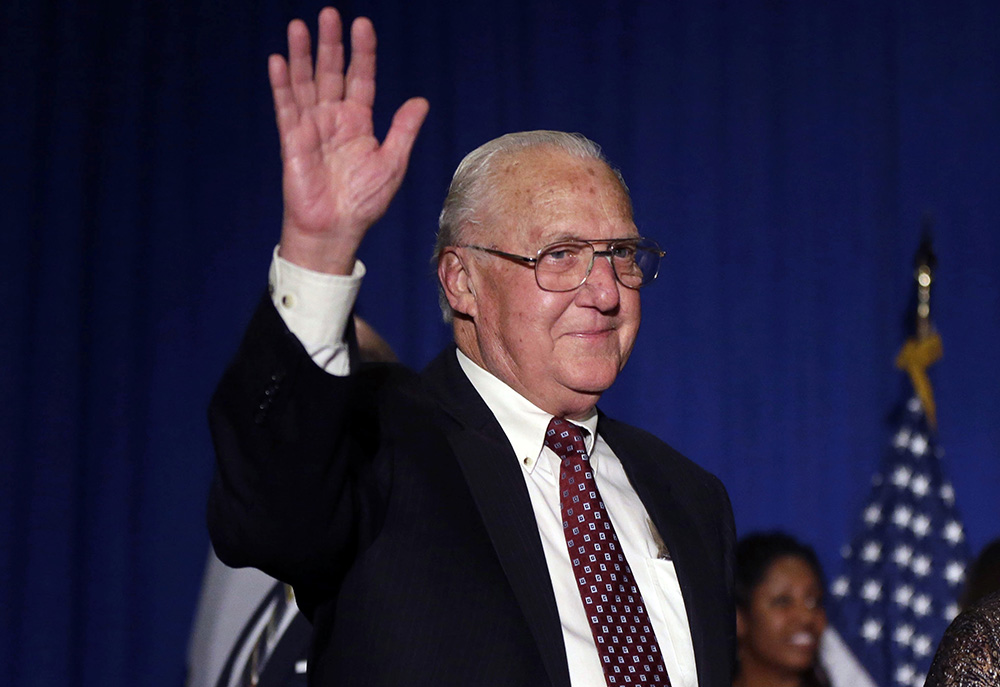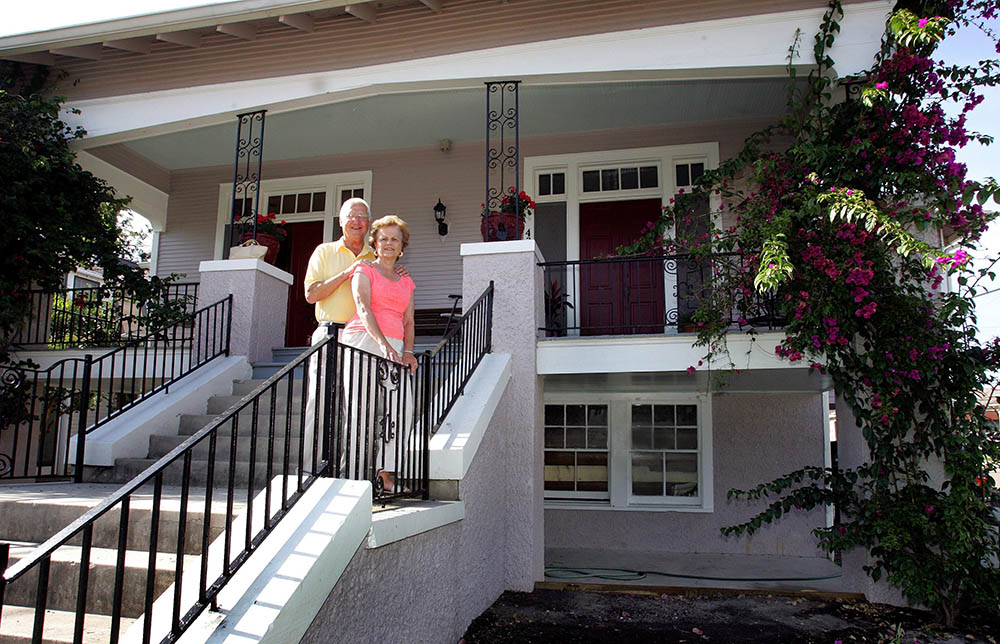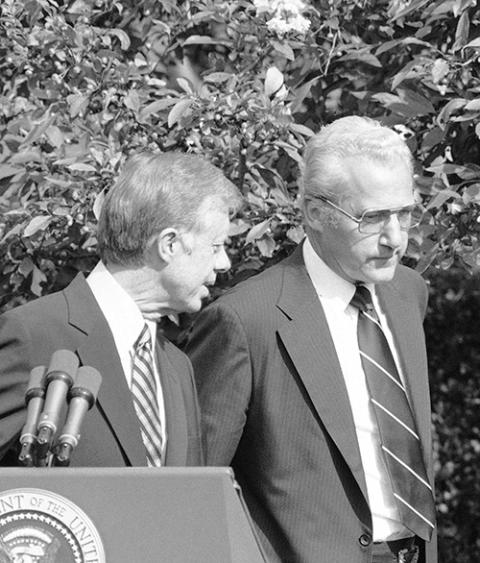
Former New Orleans Mayor Moon Landrieu waves at an event before the incumbent mayor, his son Mitch, arrives to address supporters after winning reelection in New Orleans Feb. 1, 2014. (AP/Gerald Herbert, file)
When Moon Landrieu became mayor in 1970, New Orleans was a slumbering backwater. The old-pedigree establishment synonymous with elite Carnival balls enjoyed a segregated status quo. The population of about 593,000 had a high poverty level, disproportionately so among Blacks, a voting minority hungry for economic expectations of the ebbing civil rights era.
Elected with 90% of the African American vote, Landrieu began hiring Blacks to city jobs and contracting work in record numbers; he also pushed a growth strategy anchored by the construction of the $163 million Louisiana Superdome on which he worked tirelessly with Gov. John McKeithen. Though plagued with cost overruns, the world's largest covered stadium at the time turned New Orleans into a major media sports town and spurred a downtown building boom as high-rise office towers mushroomed along Poydras Street toward the Mississippi docks.
Landrieu's achievement in eight years as mayor, balancing racial progress and economic growth, set the stage for a line of African American mayors, interrupted in 2010 when Landrieu's son, Lt. Governor Mitch Landrieu, won the mayoralty with New Orleans plagued by blight and broken streets five years after Hurricane Katrina. The second Mayor Landrieu accessed federal funds for a vast rebuilding program of the city his father had ushered into the modern world.
Moon's commitment to racial equity sparked scorn among some whites, yet when his heart stopped on Labor Day, Sept. 5, at age 92, surrounded by his wife, Verna, and the large family, praise poured out from many corners.

New Orleans Mayor Moon Landrieu on March 27, 1973, at a news conference in Washington, D.C., on the impact of the federal budget on the nation's cities (AP/John Duricka)
"I don't think most people appreciate the courage it took to make so many Black appointments," Raymond Strother, a retired Washington, D.C., political consultant who handled media relations for the Superdome early in his career, told NCR. "Moon was a truly good man in public office."
"It's because of his bold vision that we and millions of annual visitors are able to enjoy the iconic landscape of New Orleans as we know it today," Louisiana Gov. John Bel Edwards, like Landrieu a Catholic Democrat, said in a statement.
The church was bedrock in Moon's life and that of Verna (née Saterlee); they married in 1954 when he was a law student and she an undergraduate at New Orleans' Loyola University. He credited her often as his closest adviser. In the early '70s, they lived in a raised double-shotgun house with bunkbeds to accommodate the nine children — Mary, Mark, Melanie, Michelle, Mitch, Madeleine, Martin, Melinda, Maurice — on the mayor's salary of $25,000, about $97,000 in today's dollars.
At the time, Black children were enrolling in nearby St. Matthias School, and white families were starting to leave their patch of the Broadmoor area. In a 2018 memoir, In the Shadow of Statues: A White Southerner Confronts History, Mitch recalled asking his father why they weren't moving to Holy Name Parish, near Loyola, like several other families:
"Because this is where we live," he replied. "This is our neighborhood, and if we leave, the neighborhood's going to be the worse for it. And so would we. We're staying." And so they have, to this day. It is not quite an empty nest; three grandchildren are living with them today.
Political visitors of all stripes joined them at the large dinner table, affording the nine children a rare window on the world. Mary, the oldest, would eventually serve three terms as a U.S. senator. Madeleine, who won election as a local judge, is today the dean of Loyola University New Orleans College of Law. Mitch, who served two terms as mayor after twice winning election as the state's lieutenant governor, is senior adviser to President Joe Biden and infrastructure coordinator in charge of distributing funds for national rebuilding. The other four siblings went on to various careers. The family includes 37 grandchildren and 16 great-grandchildren.
According to In the Shadow of Statues, one night during Moon's tenure as mayor, amid the high-stakes work to maintain legislative support for building the totemic Superdome, the phone rang; daughter Melanie answered, and announced: "Dad, there's a nut on the phone who says he's the governor." Moon made her apologize, took the phone to do so himself and heard McKeithen laugh.

Moon Landrieu and his wife, Verna, on the steps of the family home in the Broadmoor area of in New Orleans in 2006 (AP/Judi Bottoni)
Born Maurice Landrieu on July 23, 1930, he was raised in a racially mixed working-class neighborhood in New Orleans; he later changed his given name to Moon, a nickname given by his older brother. As a baseball pitcher at Jesuit High School, he won a scholarship to Loyola in New Orleans.
Perhaps the most pivotal experience in shaping his politics came during law school in the 1950s when he befriended Norman Francis, one of the first two Blacks in the class. Moon's friend Pascal Calogero (a future Louisiana Supreme Court Chief Justice) was president of the St. Thomas More Club, and invited Francis and the other Black student to the club's annual banquet. According to the 2012 book Founded on Faith: A History of Loyola University New Orleans, when it dawned on Landrieu that they could not rent a restaurant or hotel hall for the event because of segregation laws, he persuaded his parents to host a crawfish boil for all the club members at their home. Francis, who became president of local Xavier University for many years, was one of Moon's closest friends; the children of both families grew up together.
At Loyola, two early Jesuit proponents of racial integration — Fr. Joseph Fichter, a sociologist (and future NCR board member), and Fr. Louis Twomey, a law school regent — influenced the Landrieu couple in their views on race. As Moon later told civil rights historian Kim Lacy Rogers, according to Rogers' 1995 book Righteous Lives: Narratives of the New Orleans Civil Rights Movement, he "could never equate segregation with Christianity. It didn't follow. It was all contradictory."
In 1960, he won a seat in the state legislature only to become one of two members voting against reactionary laws to thwart school desegregation. For that, he earned a finger-in-the-chest threat from Leander Perez, the boss of semifeudal Plaquemines Parish, south of the city. Perez railed against "burr heads" at rallies and swindled a fortune from mineral-rich public lands under his control; after his death, his heirs settled the litigation by paying $10 million and returning 60,000 acres to the public.
Advertisement
Standing up to the likes of Perez earned Landrieu the respect of Blacks as they registered to vote in the coming years. Archbishop Joseph Rummel excommunicated Perez in the late 1950s, but lifted the expulsion before his death in 1969, allowing Perez's funeral to be held in the church.
Landrieu won about 40% of the white vote in his first mayor's race; yet by the early '70s his forceful steps in bringing Blacks into city politics registered blowback in certain Irish Channel taverns, where some of the patrons called him "Coon" Landrieu.
Lawrence Powell, a Tulane University emeritus historian, and author of 2013's The Accidental City, an important history of New Orleans, followed Landrieu's career over many years.
"Serious federal money was available to the city when Moon became mayor," Powell told NCR. "He made the case to the establishment, at a time when the city was losing ground to Atlanta and Houston, that they needed to open the door for a rising Black professional class with political ambitions; they had a lot to bring to the table. In essence, he said to white civic leaders, 'Look guys, we can do this the hard way or the easy way but this is the new reality — this is the future.' "
When his second term ended in 1978, Landrieu left a legacy of socially transformed politics. White flight left a Black voting majority and a line of African American mayors for years to come, and a city that despite its endemic poverty became a mecca for cultural tourism.
President Jimmy Carter appointed him secretary of housing and urban development for the final year of his administration. In a chance meeting on a flight home from Washington, I asked Landrieu how he found the job. "It's a lot easier than being mayor. Weekends off. You're not worried about potholes from the blind side."

President Jimmy Carter with newly sworn-in Housing and Urban Development Secretary Moon Landrieu, right, after the swearing-in ceremony at the White House in Washington, D.C., Sept. 24, 1979. (AP file photo)
Several years later, he won election as a state appellate judge for the final years of his long career.
In several interviews, Landrieu said that he considered his family his greatest achievement.
"The arc of my father's life was one of courage," Mitch Landrieu said in a eulogy at the Sept. 10 Mass at Holy Name of Jesus, the church next to Loyola, after the receiving line that ran two-and-a-half hours ended with 750 people in pews.
"Moon Landrieu has a family he adored all of his life; he put us all through school and paid for it," he continued. "I have the greatest confidence my father is seated at the right hand of God."
The funeral was an affair of state with Gov. Edwards, Mayor LaToya Cantrell, two former mayors, White House officials, former Cabinet members who served with Moon, city council members, judges past and present, prosecutors, reporters who covered him, cops, nuns and a cross-section of the society greeted by Verna Landrieu in a front pew, flanked by a total of 62 children, grandchildren and great-grandchildren, as well as spouses, each of whom had roles in the liturgy. Joe and Jill Biden sent white roses. Archbishop Gregory Aymond officiated at the Mass, with 21 white-robed priests concelebrating.
In retirement, Moon Landrieu took long walks in Audubon Park, where we had a few pleasant encounters. Several years ago, he asked what I was working on. A history of the city, I replied. "How far back do you go?" To 1718, I said, and the founder, Bienville, a French-Canadian aristocrat and soldier.
"What do you think Bienville was like?"
"Well, his body was covered with tattoos."
Landrieu's eyebrows arched. I mentioned the citations. He nodded. "What kind of tattoos?"
"Snakes. The Indians were heavily tattooed as well."
"Being tattooed helped him deal with the Indians," Landrieu reported.
"Yessir."
He smiled. "We need to know these things."








